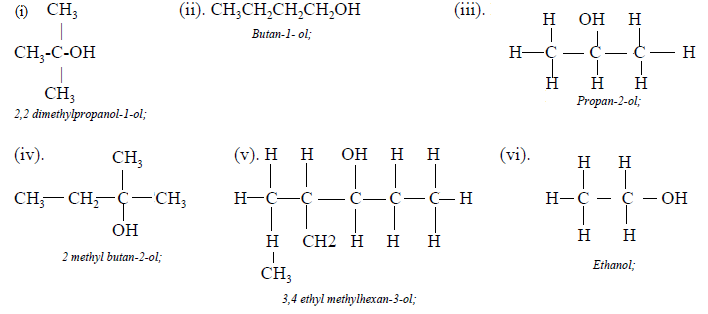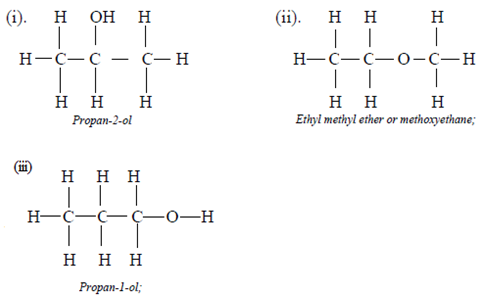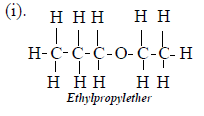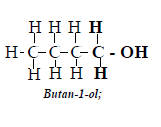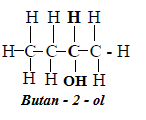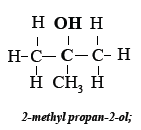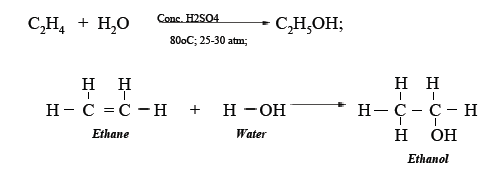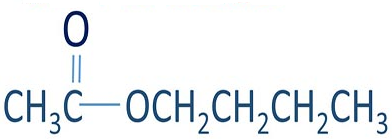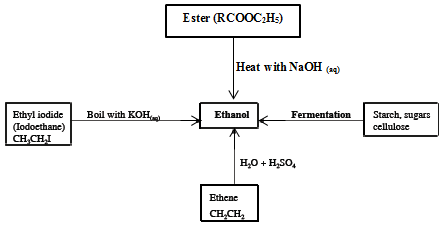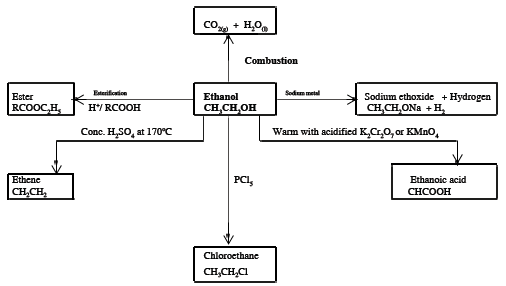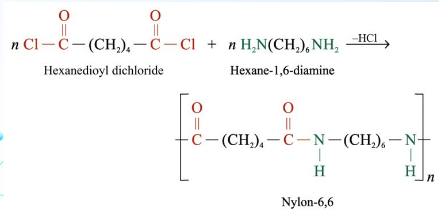- Alcohols (Alkanols)
- Akanoic Acids(Carboxylic Acids)
- Fats and Oils
- Soaps and Soapless Detergents
- Polymers

ALCOHOLS (ALKANOLS)
- They derivatives of alkanes in which a hydrogen has been replaced by a hydroxyl group (OH); which is the functional group.
- They form a homologous series of the general formula CnH2n+1OH, in which the OH can also be denoted as ROH, where R is an alkyl group.
- Note: alkanol is the IUPAC name while alcohol is the common name;
Nomenclature of Alcohols
- The e of the corresponding alkane molecule is replaced with the suffix ol;
- The parent molecule is the longest chain containing the - OH group;
- The numbering of carbon atoms is done such that the carbon atom with the hydroxyl group OH attains the lowest possible number
- The constituent branch is named accordingly;
Examples:
Isomerism in Alkanols
- Alcohols exhibit positional isomerism due to the fact that the position of attachment of the functional group varies within the carbon chain;
- Examples of isomeric alcohols
- Isomers of propanol
Note: Ethyl methyl ether is not actually an alcohol as it lacks the OH group;
All have the molecular formula: C3H7OH - Isomers of butanol
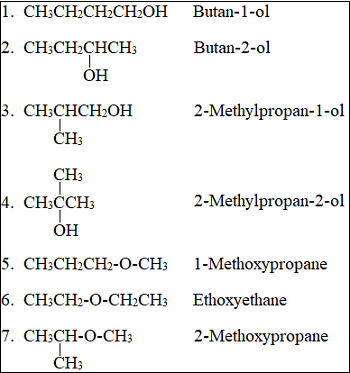
Note: All have the molecular formula: C4H9OH - Draw the Isomers of pentanol, C5H11OH;
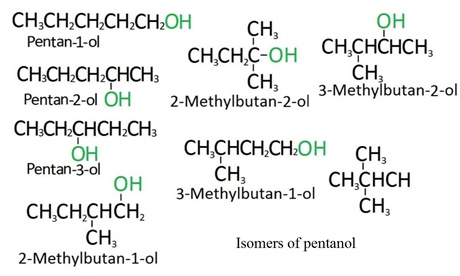
- Isomers of propanol
Primary, Secondary and Tertiary Alcohols
Primary Alcohols
- Are alcohols in which the OH group is attached to a carbon atom to which 2 hydrogen atoms are attached;
- Thus they contain a CH2OH group;
Examples :
Secondary Alcohols
- Are alcohols in which the hydroxyl group is attached to the carbon atom to which only one other hydrogen atom is attached;
- The carbon atom with the OH group is thus bonded to two carbon atoms;
- They contain a CHOH group;
Examples:
Tertiary Alcohols
- The hydroxyl group is attached to a carbon atom with no hydrogen atoms attached
- The carbon atom with the OH group is bonded to 3 other carbon atoms; hence sorrounded by the methyl groups;
- Tertiary alcohols thus a contain a COH group;
Examples:
Preparation of Alkanols
- Alkanols are prepared from three main methods.
- Hydrolysis of halogenoalkanes;
- Hydration of alkenes
- Fermentation of starches and sugars (mainly for ethanol)
Hydrolysis of Halogenoalkanes
- Halogenoalkanes are compounds in which one or more hydrogen atoms in an alkane are replaced by halogens;
- Addition of aqueous KOH or NaOH to a halogenoalkane and heating results to corresponding alcohol;
- Reaction involves replacement of the halogen atoms with the -OH from the alkali;
Examples:- Preparation of methanol
- Preparation of propanol;
- Preparation of methanol
- Note: - the conversion of a halogenoalkane to an alcohol is known as hydrolysis;
- Reagent in this case is an alkali and condition for reaction is heat;
Hydration of Alkenes.
- Conversion of an alkene to an alcohol is known as hydration ;
- Main reagent for the reaction is water;
- Conditions for the reaction are:
- An acid catalyst, mainly conc. H2SO4 or phosphoric acid (H3PO4);
- High temperatures of about 80oC;
- High pressures of about 25-30 atmospheres;
Examples:- Preparation of ethanol from ethene.
- Preparation of butanol from butene.
Preparation (of ethanol) by Fermentation.
- It is prepared from the fermentation of starches or sugars in the presence of yeast;
- Fermentation: Is a chemical decomposition brought by bacteria or yeast (anaerobically) usually accompanied by evolution of carbon (IV) oxide and heat.
The chemical process - Starch is broken into sugars by the action of the enzyme amylase or diastase ;
Word equation Break up into
Starch molecule + water → sucrose molecules
Chemical equation Amylase
(C6H10O5)n → nH2O + nC6H12O6
Starch Water many sucrose molecules - When yeast is added to dilute sucrose solution (ordinary sugar); the enzyme sucrase in yeast catalytically breaks down sugar (sucrose) into the simplest sugars, glucose and fructose i.e.
Equation: Sucrase
C12H22O11(aq) + H2O(l) → C6H12O6(aq) + C6H12O6(aq)
Sugar Water glucose fructose - Finally the enzyme zymase , also produced by yeast converts glucose and fructose into ethanol and carbon (IV) oxide.
Equation: Zymase
C6H12O6(aq) → 2C2H5OH(aq) + CO2(g)
Glucose/fructose ethanol carbon (IV) oxide
Optimum Conditions for fermentation:- Temperatures of 25-30oC;
- Yeast catalyst;
- Absence of oxygen (airtight);
- When the reaction mixture contains about 12% by volume of ethanol, the activity of yeast ceases.
- This is because higher ethanol concentrations kill the yeast cells;
- Fermentation provides about 10% alcohol by volume;
- The concentration of resultant ethanol can be increased by fractional distillation .
- During the process, ethanol distills over fast due to its lower boiling point (78°C)
- The distillate at below 95°C is first collected (leaving water behind).
- The resultant fraction will have 95% alcohol by volume; and is called rectified spirit ;
- Absolute ethanol; which is 99.5% by volume can be obtained by re-distillation of rectified ethanol between 78-82oC to remove all the water in the mixture;
- This can be done in two main ways:
- Addition of a small amount of benzene to the rectified spirit and then distilling; (benzene dissolves in the water in the alcohol)
- Distillation of rectified spirit over a suitable drying agent like calcium oxide and then over calcium; (calcium reacts with steam, calcium oxide takes in condensed water)
Properties of Alcohols (Ethanol)
Physical Properties
- It is a colourless, volatile liquid soluble in water in all proportions forming a neutral solution;
- Has a characteristic smell and boils at78.5°C
Variation in Physical Properties of Alkanols.
| Name | Molecular Formula | Molecular mass | Boiling point (oC) | Melting Point (oC) | Solubility in 100g of water |
| Methanol | CH3OH | 32 | 64.5 | -94 | Soluble |
| Ethanol | C2H5OH | 46 | 78.5 | -117 | Soluble |
| Propanol | C3H7OH | 60 | 97 | -127 | Soluble |
| Butanol | C4H9OH | 74 | 117 | -90 | Slightly soluble |
| Pentanol | C5H11OH | 88 | 138 | -79 | Slightly soluble |
| Hexanol | C6 H13OH | 102 | 158 | -52 | Slighlty soluble |
| Heptanol | C7H14OH | 116 | 175 | -34.6 | Very slightly soluble |
| Octanol | C8H16OH | 194 | 194 | -16 | Very slightly soluble |
Note:
- Solubility of alkanols decreases with increase in molecular mass ;
- Both melting and boiling points increases with increase in the relative molecular mass; due to progressive increase in number of van der waals forces;
- Alkanols have higher melting and boiling points than their corresponding alkanes with the same molecular formula;
Reason: - Alkanols have hydrogen bonding between their molecules, caused by the presence of the OH group; alkanes have van der waals between its molecules; Hydrogen bonds are stronger than weak van der waals;
Hydrogen bonding between 2 ethanol molecules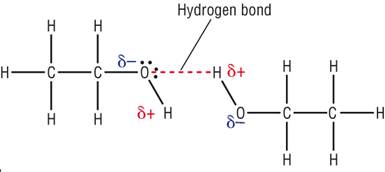
Chemical Properties/Main Reactions of Ethanol.
- Note; the main reactions of ethanol are those of its functional group OH;
(i) Combustion
Procedure - A few drops of ethanol are placed in a watch glass and lit.
- A dry gas jar is held over the flame and the gas collected tested with limewater.
Observation: - It burns with a blue flame , which is almost colourless.
- The resultant gas turns limewater into a white precipitate, indicating it is carbon (IV) oxide.
Explanations: - Ethanol (alcohols) burns in air (oxygen) producing carbon (IV) oxide, water and heat energy;
- The lower members of the homologous series burn with a blue or non-luminous flame leaving no residue;
- As the hydrocarbon chain increases the flame becomes more luminous and smoky and a black residue remains;
Equation
C2H5OH(l) + 3O2(g) → 2CO2(g) + 3H2O(l)
Note: - If an alkanol is burnt in a limited supply of oxygen, then the combustion is incomplete and the products include carbon (II) oxide or carbon and water
Equations - C2H5OH(l) + 2O2(g) → 2CO(g) + 3H2O(l)
- 2C2H5OH(l) + 2O2(g) → 4C(s) + 6H2O(l)
(ii) Reaction with metals (sodium);
Procedure: - Tiny pieces of sodium one at a time; are added 1cm³ of pure ethanol in a boiling tube.
Observation; - Sodium metal darts on the surface of the ethanol and then dissolves/disappears;
- The beaker becomes warmer indicating an exothermic reaction .
- Effervescence occurs and bubbles of a colourless gas are observed; gas burns with a pop sound.
Explanation: - Sodium reacts with alcohol much as it does with water but the reaction is more gentle .
- Sodium reacts with ethanol to produce hydrogen gas , which on testing burns with a pop sound.
- The reaction is exothermic producing heat hence warmer beaker.
- A clear solution of sodium ethoxide is left formed in the boiling tube.
Equation;
2C2H5OH(l) + Na(s) → 2CH3CH2ONa(l) + H2(g)
Note: - Alkanols react with electropositive metals such as sodium, potassium and aluminium to liberate hydrogen gas and form a solution of the metal salt, the metal alkoxide;
Examples
2CH3CH2CH2OH(l) + Na(s) → 2CH3CH2CH2ONa(l) + H2(g)
Propanol Sodium metal Sodium propoxide hydrogen
CH3CH2CH2CH2CHOH(l) + K(s) → 2CH3CH2CH2CH2CHOK(l) + H2(g)
Pentanol Potassium Potassium pentoxide Hydrogen - Note: The reactivity of alkanols with metals decreases as the hydrocarbon chain increases;
(iii) Esterification; - It is the production of esters (alkyl alkanoates) from the reaction between alcohols and carboxylic acids;
Procedure - 2-3 drops of concentrated sulphuric acid are added to a mixture of equal proportions of ethanol and pure ethanoic acid in an evaporating dish.
- The mixture is warmed gently in a water bath for sometime.
- The mixture is poured into a beaker and smelt;
Observation - A fruity sweet smell (of ethyl ethanoate);
Explanation - Ethanol reacts with ethanoic acid in the presence of a few drops of concentrated sulphuric acid to form ethyl ethanoate and water.
- The reaction is very slow and so catalyzed by the hydrogen ions from the sulphuric acid.
Equation Conc. H2SO4;warm
C2H5OH(l) + CH3COOH(aq) ⇌ CH3COOC2 H5(l) + H2O(l)
Ethanol ethanoic acid ethyl ethanoate (ester) water
Structurally; - The alkyl part of the ester is derived from the alkanol , while the alkanoate part is derived from the alkanoic acid;
- The alkanol attaches itself at the group in the carboxylic acid thereby displacing hydrogen atom;
- Under ordinary conditions the reaction takes place slowly; but in presence of concentrated sulphuric acid which act as a catalyst and warm (heat) conditions, the reaction is enhanced;
Further examples:
Write balanced equations for each of the following esterification reactions:- Ethanol and propanoic acid;
- Propanol and ethanoic acid;
- Ethanol and methanoic acid;
Note: - Generally a reaction between alcohol and a carboxylic acid (-COOH-) produces an ester and water in a process called Esterification;
General equation: Conc. H2SO4; warm
Organic acid + alcohol ⇌ ester + water (Esterification), while;
Inorganic acid + alkali → salt + water (Neutralization)
Differences between neutralization and Esterification- Esterification is slower than neutralization as the reaction is between molecules and not ions as in neutralization
- Esterification is reversible; the forward reaction is esterification and the backward reaction is hydrolysis.
- Esterification results to esters which are covalent compound; neutralization forms salts which are electrovalent.
Name and formulae of some common esters.
Alkanol Alkanoic acid Ester Methanol
CH3OHPropanoic acid
Methylpropanoate
Ethanol
C2H5OHMethanoic acid
Ethylmethanoate
Propan-1-ol
C3H7OHEthanoic acid
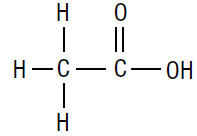
Propylethanoate
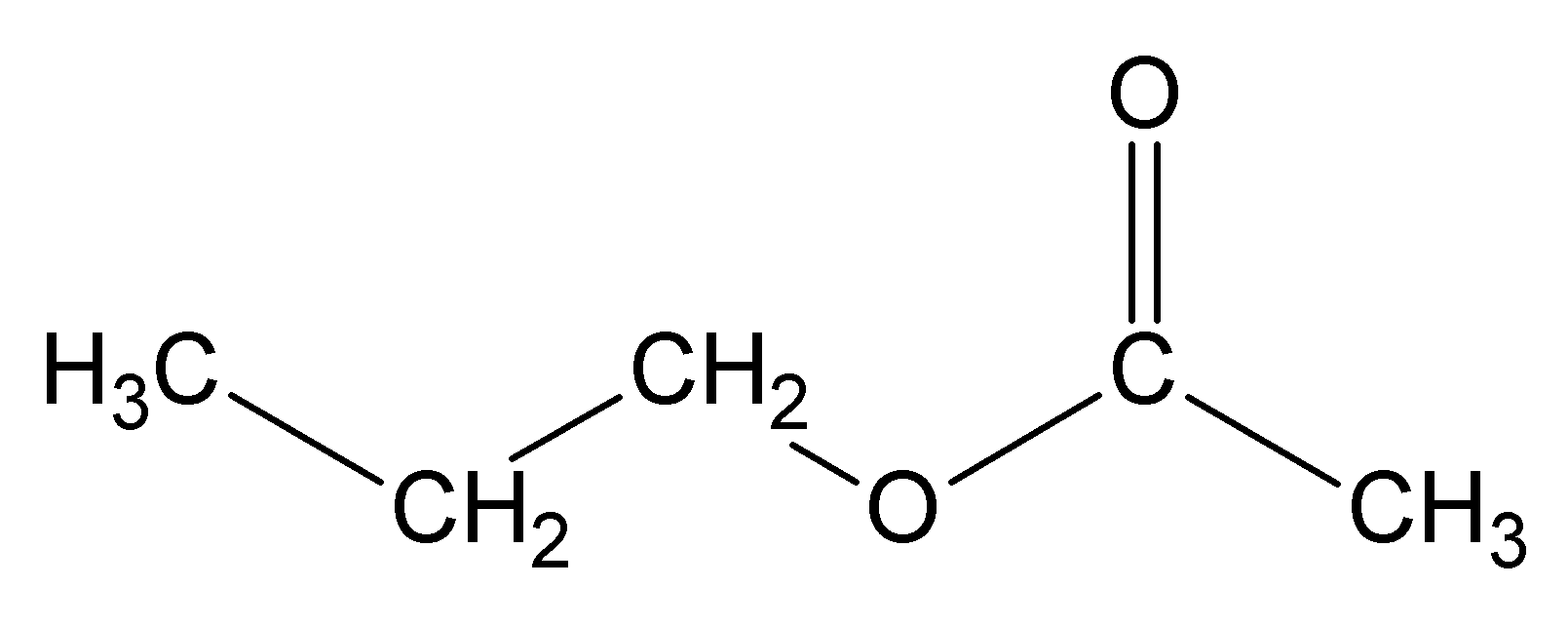
Butanol
C4H9OHEthanoic acid

Butylethanoate
(iv) Oxidation of primary alkanols; - On heating in presence of oxidising agents, primary alkanols are oxidised to alkanoic acids;
Note: - During oxidation of alcohols, they first lose hydrogen to form compounds called aldehydes (compounds ending in al)
- The resultant aldehydes (alkanal) then gain oxygen to form alkanoic acids.
Equations: - Alkanol + hydrogen → alkanal + water
Then; - Alkanal + oxygen → alkanoic acid;
General equation:
Example: Oxidation of ethanol - Ethanol like all other alcohols is oxidized by strong oxidizing agents such as potassium dichromate (VI) and potassium manganate (VII) to form ethanoic acid.
- Reaction with acidified potassium dichromate (VI):
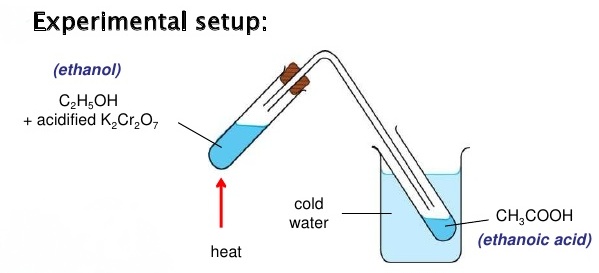
Procedure
-A little solution of acidified potassium dichromate (VI) is added to a little solution of ethanol in a test tube and then warmed gently;Observation:
-The solution (dichromate) changes from yellow to green;Explanation
- The acidified potassium dichromate (VI) oxidizes the ethanol to ethanal then to ethanoic acid, while the dichromate undergoes reduction (chromate (VI) to Cr3+ changing colour from yellow to green ;Equations
Structurally:
Then;General equation
- Reaction with acidified potassium manganate (VII).
Procedure
-Acidified potassium permanganate solution is added to ethanol in a test tube end the mixture is warmed gently.Observation
-The permanganate solution turns from purple to colourless.
-The characteristic smell of ethanoic acid is felt.Explanation
-The ethanol is oxidized to ethanal then to ethanoic acid. The reduced permanganate decolorizes (turns from purple to colourless);
-The H+/KMnO4 is decolourised due to reduction of manganate (VII) ions to Mn2+General equation:
- Catalytic Oxidation of Alkanols.
-Catalytic oxidation of alkanols results to a dehydrogenation (removal of hydrogen) resulting to the formation of an alkanal (aldehyde);
-These are compounds with the functional group COH;
Example: Catalytic oxidation of ethanol with hot copper metal
-When ethanol is passed over heated copper at about 300°C, it is dehydrogenated i.e. hydrogen is removed.
-This results into formation of an ethanal; and hydrogen gas is liberated.
- Reaction with acidified potassium dichromate (VI):
- Dehydration is the removal of water molecules from a compound;
- Excess concentrated sulphuric (VI) acid dehydrates alkanols and forms corresponding alkenes.
Conditions required: - - High temperatures of 140-180°C.
- Catalysts such as conc. sulphuric acid, phosphoric acid and aluminium oxide;
Example: Dehydration of ethanol
Apparatus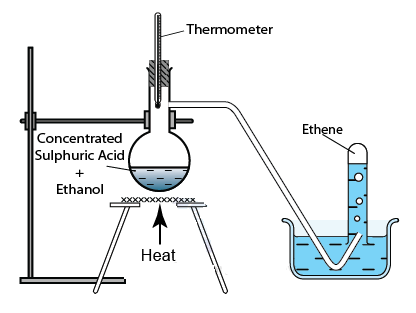
Procedure - 15cm3 of absolute ethanol are put in around bottomed flask and 5cm3 of con H2SO4 added.
- The contents are mixed thoroughly by swirling the flask.
- The flask is then heated (warmed) gently with little shaking for about 1 minute.
- The gas collected is tested with acidified potassium manganate (VII) and bromine water.
Observations - Evolution of a colourless gas that decolourises the purple acidified potassium manganate (VII)
- The resultant gas also decolourises the red brown bromine water.
Explanations - On heating the alkanol (ethanol) undergoes an elimination reaction.
- It loses both a hydrogen (H) and a hydroxyl (OH) from two adjacent carbon atoms.
- The H and OH combine to form water; and the remnants form ethene.
- The sulphuric acid acts as a catalyst.
Note: Disadvantage of concentrated sulphuric acid over phosphoric acid.
- Being a strong oxidising agent the concentrated sulphuric acid oxidizes some of the alkanol formed to CO2 and it is itself reduced to SO2 ;
-This reduces the volume and purity of resultant alkanol; and is also a potential source of pollution;
Equation
Note:
With cold concentrated sulphuric (VI) acid, alkanols react to form alkyl hydrogen sulphates.
Example: Ethanol and cold conc. sulphuric acid.
C2H5OH + H2SO4(l) → C2H5HSO4(l) + H2O(l)
Ethanol Ethyl hydrogen sulphate(Ethoxyethane)
Uses of Ethanol
- Used as solvents; in the preparation of drugs, perfumes, liquors, vanish and paints.
- Source of fuel e.g ethanol when blended with gasoline to form gasohol.
Note:
- Addition of ethanol to petrol improves the antiknock propertied of petrol, due to its low ignition point;
- The alkanol also absorbs any traces of moisture that may enter and damage the petrol system;
- Alkanols also ignite on their own to liberate heat;
Example:
CH3CH2OH(l) + 3O2(g) → 2CO2(g) + 3H2O(l) ΔH = -1368KjMol-1 - Starting material for the manufacture of polyvinyl chloride (P.V.C)
- Ethanol is used as a disinfectant (antiseptic) at special concentrations e.g for cleaning tissues and surgical equipments during operations and in dressing wounds;
- Manufacture of alkanoic acids e.g ethanoic acid
- Ethanol is used as thermometer liquid for measuring low temperatures;
- Manufacture of alcoholic drinks
- Large amounts of methanol are used in the manufacture of formaldehyde a chemical used in preservation of corpses;
- They are used as antifreeze mixtures in car radiators e.g a mixture of ethanol and water freezes at lower temperatures that pure water;
- Manufacture of esters to giver fruity flavourings for confectionery and drinks;
Tests for Primary Alkanols
- Reaction with sodium metal
- Alkanols liberate hydrogen gas, a colourless gas that burns with a pop sound;
Equation:
2CH3CH2OH(l) + 2Na(s) → 2CH3CH2ONa(l) + H2(g) - Reaction with phosphorus (V) chloride:
- Alkanols liberate misty fumes of hydrogen chloride gas;
Equation:
PCl5 (s) + CH3CH2OH(l) → 2CH3CH2OP(l) + HCl2(g)
Note:
- Both alkenes and alkanols decolourise the purple acidified potassium manganate (VII);
- However, alkenes decolourise the red bromine water; while alkanols do not.
Summary on Preparation of Alkanols (Ethanol)
Summary on Reactions of Alkanols

ALKANOIC ACIDS (CARRBOXYLIC ACIDS)
- Also called organic acids and form a homologous series with a general formula of CnH2n-1OOH
- The formula can also be written as CnH2n+1COOH; in which case n = (no. of carbon atoms −1)
- Members differ from each other by an additional CH2 group.
- Their functional group is the carboxylic group (-COOH) which is attached to the alkyl group.
- Graphical representation of carboxyl group is as shown below;
Note: All carboxylic acids have the COOH as the functional group but alkanoic acids are strictly alkanoic acids derived from alkanes
Nomenclature of Alkanoic Acids
- The ending of the corresponding alkane is replaced by ′ oic acid .
Examples;
- Methane to methanoic acid.
- Ethane to ethanoic acid. - They are named as if they are derived from alkanes through replacement of one of the hydrogen atoms by the -COOH group.
Note: - Unlike alkanols the functional group (COOH) in alkanoic acids can only be at the end of the carbon chain. - The C in the COOH is always given the first position, while the substituents are given locants (numbers in reference to the first position).
Examples:
IUPAC name Old (traditional) name Structural formula Methanoic acid Formic acid Ethanoic acid Ethanoic acid 
Propanoic acid Propionic acid Ethanedioic acid Oxalic acid Butanedioic acid Succinic acid
Branched Alkanoic Acids
- The naming of branched alkanoic acids follow the same general rules like that of alkanes; as long as the carbon atom with the COOH group is given the first position.
- The branch can either be an alkyl group or a halogen other than hydrogen.
Examples:
Compound IUPAC name 2 - chloroethanopic acid 3 - methylpropanoic acid 2 - hydroxypropanoic acid 2 - hydroxy, 2 - methylpropanoic acid 4 - bromo, 3 - chlorobutanoic acid
Isomerism in Alkanoic Acids
- Due to the existence of branched alkanoic acids, it is possible to obtain various isomers for a given alkanoic acid;
Example:
Draw all the isomers of pentanoic acid. (3 marks)
Preparation of Alkanoic Acids
- Industrial Manufacture
- Is done by the oxidation of primary alkanols using air (oxygen) as the oxidising agent.
Conditions:
- Moderate temperatures
- 5 atm pressure
- Hot copper catalyst; - Laboratory preparation.
- Is done by the oxidation of primary alkanols using acidified potassium dichromate (VI).
Example: Laboratory preparation of ethanoic acid.
Apparatus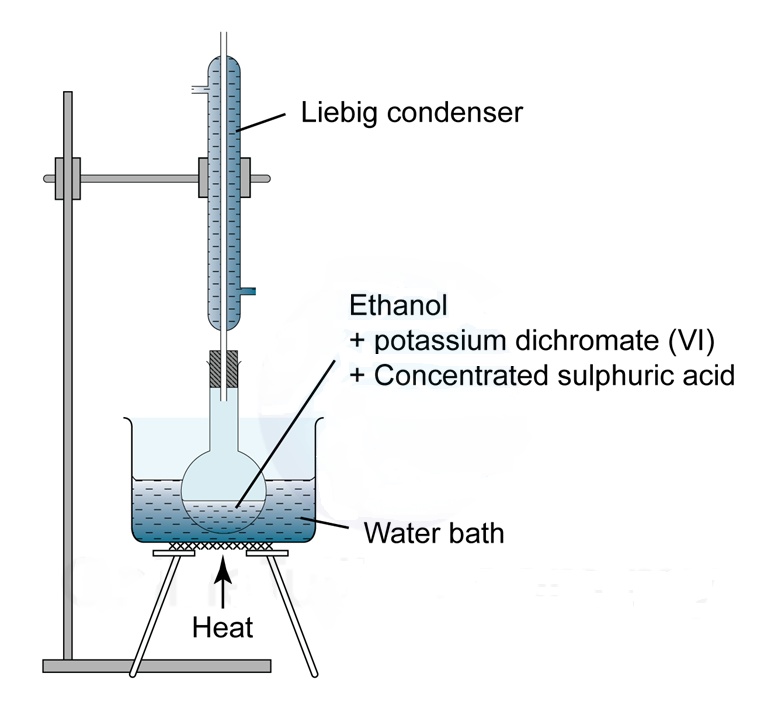
Procedure
- Acidified potassium dichromate (VI) is heated in a water bath and ethanol added slowly from a water bath.
- The mixture is heated further and then distilled.
- The distillate is collected at about 105oC.
Observations and explanations.
-Colour of potassium dichromate (VI) changes from orange to green.
Reason:
-The dichromate ions are reduced to chromium (III) ions.
Equation:
Cr2O72-(aq) + 14H+(aq) + 6e- → 2Cr3+(aq) + 7H2O(l)
- The ethanol is oxidised to ethanal (acetaldehyde); which is further oxidised to alkanoic acid.
Equations
Structurally:
Then;General equation
Properties of Alkanoic Acids
Gradation in Physical Properties of Alkanoic Acids
| Name of acid | Formula(structural) | Molecular Formula | M.P oC | B.P oC | Solubility |
| Methanoic acid | HCOOH | CH2O2 | 8.4 | 101 | Most Soluble |
| Ethanoic acid | CH3COOH | C2H4O2 | 16.6 | 118 | ↑ increasing solubility |
| Propanoic acid | CH3CH2COOH | C3H6O2 | -20.8 | 141 | |
| Butanoic acid | CH3CH2CH2COOH | C4H8O2 | -6.5 | 164 | |
| Pentanoic acid | CH3CH2CH2CH2COOH | C5H10O2 | -34.5 | 186 | |
| Hexanoic acid | CH3(CH2)4COOH | C6H12O2 | -1.5 | 205 | Least soluble |
Physical Properties of Ethanoic Acid
- A colourless liquid with a sharp pungent smell.
- B.P is 118o C and freezes at 17° c forming ice like crystals termed as glacial ethanoic acid.
- It is soluble in water and is weakly acidic with a P.H of approximately 4.8.
Note - Concentrated ethanoic acid is only slightly ionized and is a poor conductor of electricity
- On dilution its conductance steadily improves as the extent of ionization increases
Chemical Properties (reactions) of Alkanols.
- Reaction with carbonates.
- Alkanoic acids react with metal carbonates to form a salt (metal alkanoate), carbon (IV) oxide and water.
Examples:
Ethanoic acid and sodium carbonate
- Ethanoic acid reacts with sodium carbonate to form sodium ethanoate and water with the liberation of carbon (IV) oxide gas.
Equation
Na2CO3(s) + 2CH3COOH(l) → 2CH3COONa(aq) + CO2(g) + H2O(l)
Sodium carbonate Sodium ethanoate
Zinc carbonate and ethanoic acid.
ZnCO3(s) + 2CH3COOH(l) → (CH3COO)2Zn(aq) + CO2(g) + H2O(l)
Zinc carbonate Zinc ethanoate - Reaction with metal hydroxides (Neutralization)
-Alkanols neutralize alkalis like sodium hydroxide forming a salt (metal alkanoate) and water only.
Examples:
Sodium hydroxide and ethanoic acid.
CH3COOH(l) + NaOH(aq) → CH3COONa(aq) + H2O(l)
Ethanoic acid Sodium hydroxide Sodium ethanoate
Potassium hydroxide and methanoic acid
HCOOH(l) + KOH(aq) → HCOOK(aq) + H2O(l)
Methanoic acid Potassium hydroxide Potassium methanoate - Reaction with metal oxides (neutralization).
- Alkanoic acids react with metal oxides to produce salt (metal alkanoate and water only.
Examples:
Ethanoic acid and copper (II) oxide.
2CH3COOH(l) + CuO(s) → (CH3COO)2Cu(aq) + H2O(l)
Ethanoic acid Copper (II) oxide Copper ethanoate - Reaction with Metals
-Alkanoic acids react with reactive metals to form a salt (metal alkanoate) and hydrogen gas;
Examples:
Ethanoic acid and sodium metal
2CH3COOH(l) + Na(s) → 2CH3COONa(aq) + H2(g)
Ethanoic acid Sodium ethanoate
Propanoic acid and magnesium metal
2CH3CH2COOH(l) + Mg(s) → (CH3CH2COO)2Mg(aq) + H2(g)
Propanoic acid Magnesium propanoate - Reaction with Alkanols (Esterification)
- Alkanoic acids react with alkanols to form esters;
Conditions:
- Drops of concentrated sulphuric acid.
- Gentle warming.
Reaction of ethanoic acid
- Ethanoic acid reacts with ethanol in the presence of a few drops of concentrated sulphuric acid forming a sweet fruity smelling compound called ester.
- The process is called esterification.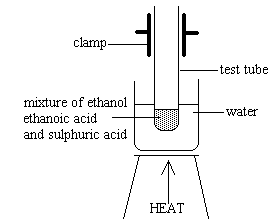
Procedure
- 2-3 drops of concentrated sulphuric acid are added to a mixture of equal proportions of ethanol and pure ethanoic acid in a test tube.
- The mixture is warmed gently in a water bath for sometime.
- The mixture is poured into a beaker and smelt;
Observation
- A fruity sweet smell (of ethyl ethanoate);
Explanation
- Ethanol reacts with ethanoic acid in the presence of a few drops of concentrated sulphuric acid to form ethyl ethanoate and water.
- The reaction is very slow and so catalyzed by the hydrogen ions from the sulphuric acid.
Equation Conc. H2SO4; warm
C2H5OH(l) + CH3COOH (aq) ⇌ CH3COOC2H5(l) + H2O(l)
Ethanol ethanoic acid ethyl ethanoate (ester)
Structurally
- The alkyl part of the ester is derived from the alkanol, while the alkanoate part is derived from the acid;
- The alkanol attaches itself at the group in the carboxylic acid thereby displacing hydrogen atom;
- Under ordinary conditions the reaction takes place slowly; but in presence of concentrated sulphuric catalyst and warm (heat) conditions, the reaction is enhanced;
- If propanol was used in place of ethanol, the reaction would yield the ester propyl ethanoate, according to the following equation;
CH3COOH(aq) + CH3CH2CH2OH(aq) ⇌ CH3COOCH2CH3(aq) + H2O(l)
Ethanoic acid Propanol Propylethanoate
Note:
- Esters react with water to form the respective alkanoic acid and alkanol.
- This reaction is termed hydrolysis and occurs in presence of concentrated sulphuric acid and heat as conditions.
Example: Conc. H2SO4
CH3COOCH3(aq) + H2O(l) → CH3COOH(l) + CH3OH(l)
Methyl ethanoate Heat Ethanoic acid Methanol - Reaction with ammonia.
- Alkanoic acids react with ammonia to produce the ammonium salt of the acid.
- General formula of the ammonium alkanoate salt is RCOONH4
Example:
Ethanoic acid and ammonia gas.
CH3COOH(l) + NH3(g) → CH3COONH4(aq)
Uses of Alkanoic Acids (Ethanoic Acid)
- In pharmaceuticals, for making medicines e.g ethanoic acid is used in the manufacture of aspirin.
- Manufacture of dyes and insecticides
- Seasoning food as vinegar
- Coagulation of rubber latex
- Preparation of polyethenyl ethanoate and cellulose ethanoate which are used are used to make artificial fibres such as rayon.
- Manufacture of soaps.
- Preparation of perfumes and artificial favours used in food manufacture.
Tests for Alkanoic Acids
- The following tests can be used to test for alkanoic acids.
- Reaction with carbonates and hydrogen carbonates
- Esterification
Summary: Draw a summary flow chart to show all the reactions of a named alkanoic acid.

FATS AND OILS
- Are esters of long chain carboxylic acids and glycerol
- Oils
- Oils occur naturally in plants and animals.
Examples: Whale oil, groundnut oil, corn oil and castor oil. - Oils are liquids at room temperature.
Reason: - They have high proportion of esters derived from the unsaturated oleic acid in them.
- Oils occur naturally in plants and animals.
- Fats.
- These occur naturally in animals only.
Examples: Tallow, butter from milk, lard from pigs etc. - Fats are solids at room temperature
- Oils can be converted to fats/hardened into fats by hydrogenation.
- This is the conversion of oils into fats by use of hydrogen; and forms the basis of margarine manufacture.
- During hydrogenation:
- Hydrogen is bubbled into oils under high pressure and temperatures of about 400oC in the presence off a nickel catalyst
- These occur naturally in animals only.
- Oils
- Note
- Fats and oils are important raw materials in the manufacture of soaps.
SOAPS AND SOAPLESS DETERGENTS
Soaps
- Are a variety of compounds produced when oils or fats are reacted with sodium hydroxide.
- They are similar in that they contain a long hydrocarbon chain ending in a carboxylate anion to which is attracted a sodium cation.
- A typical soap is sodium stearate; C17H35COO-Na+
Structurally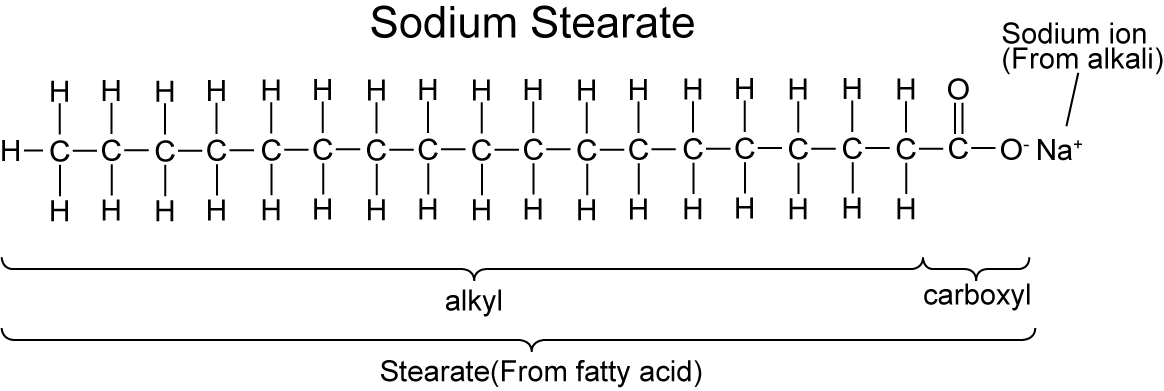
Preparation of Soaps
-
- 2cm3 of castor oil and 10 cm3 of 4M sodium hydroxide are poured into a 100cm3 beaker.
- The mixture is then heated for about 10 minutes, stirring continuously and adding distilled water to make up for evaporation.
Explanation:
On boiling an alkali with fat or oil, a hydrolysis reaction occurs.
Equation:
When hydrolysis reaction occurs in the presence of an alkali (sodium hydroxide), the process is known as saponification (the chemical reaction between a fat and an alkali) - In the fat hydrolysis NaOH neutralizes the acid formed (i.e. stearic acid) to form the sodium salt of the acid removing it from the aqueous mixture.
- Thus in excess alkali, all the fat is utilized.
- The sodium salt (sodium stearate) of the acid is termed soap if the number of carbon atoms per molecule is more than eight.
Note: - KOH may be used in place of NaOH as the alkali.
- To the boiled mixture 3 spatula measures of sodium chloride are added, stirred well and allowed to cool.
Reason:
- The NaCl helps in separating the soap from the glycerol.
- This step is called salting and it reduces the solubility of the soap in the aqueous layer.
- The lower layer consists of glycerol, salts and unused alkali solution.
General formula of ordinary soap
CnH2n+1COO-Na+ where n > 8 (n is greater than eight) - The solid is filtered off and washed with cold distilled water, to remove impurities like NaCl
- The solid sample is placed in a test tube with distilled water, then with tap water.
Note:
- The resultant soap may not have lathered easily with tap water.
Reason:
- Some tap water contains a high proportion of calcium or magnesium ions that make water hard.
Summary on Soap Preparation
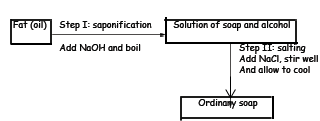
The Role of Soap in Cleaning
Note: functions of soap in water
- It makes the water able to wet material more effectively by lowering the surface tension.
- Emulsification of oil and grease.
- Soap molecules have two dissimilar ends:- A hydrocarbon chain which is non-polar and has no attraction for water- hence oil soluble
- A Carboxylate end , which is polar and is attracted to water; hence is water-soluble.
Note: the Carboxylate end is in fact negatively charged in water because after dissolution, the sodium ion and the carboxylate ion exist as separate entities.
Illustration:
Effects of Soap on Oil Water Mixture (removal of oils and grease during washing)
Note: schematic representation of a soap molecule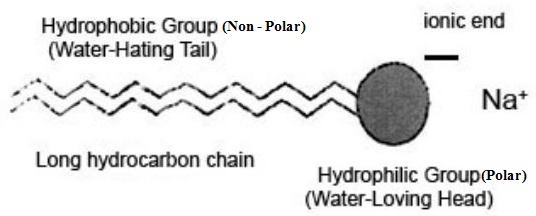
- On adding soap into oil water mixture the following build up occurs:
- A molecule of soap has a polar (hydrophilic) and non-polar (hydrophobic) parts;
- The non-polar end dissolves in oil and the polar end dissolves in water.
- When the mixture is agitated (thoroughly shaken) the hydrocarbon chain (tail) dissolves in grease while the carboxylate sodium end of the soap molecule (the head) remains dissolved in water.
Diagram: role of soap in cleaning.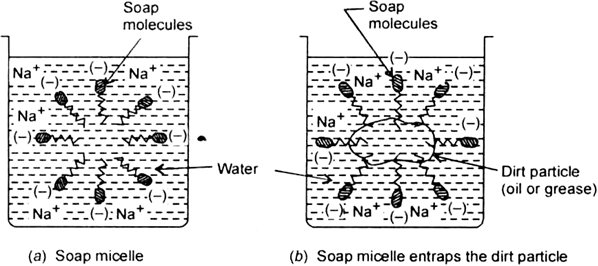
NB: A micelle is formed when a variety of molecules including soaps and detergents are added to water. The molecule may be a fatty acid, a salt of a fatty acid (soap), phospholipids, or other similar molecules.
- Each oil drop ends up with a large cloud of negative charge around it as the polar heads are negatively charged.
- Consequently the oil drops repel each other, hence preventing them from coalescing.
- The water soluble sodium heads on the surface of the droplets keep the droplets emulsified (suspended) in the water.
- During rinsing the water carries away the oil droplets.
Effect of Hard Water on Soap
- The Calcium and magnesium ions in hard water react with soap (sodium stearate) and remove it as an insoluble grey scum of magnesium or calcium stearate .Equations:
- 2C17H35COO-Na+(aq) + Ca2+(aq) → (C17H35COO-)2Ca2+(s) + 2Na+(aq)
Sodium stearate (soap) Calcium stearate - 2C17H35COO-Na+(aq) + Mg2+(aq) → (C17H35COO-)2Mg2+(s) + 2Na+(aq)
Sodium stearate (soap) Magnesium stearate
- 2C17H35COO-Na+(aq) + Ca2+(aq) → (C17H35COO-)2Ca2+(s) + 2Na+(aq)
- Soap is wasted in this way until all the calcium (II) and magnesium (II) stearate has been removed.
- The resultant scum is deposited on fabrics, giving them an unsightly dull appearance.
- Thus in hard water districts it is obviously advantageous to remove hardness before washing.
Removal of Hardness:
- Depends on whether the hardness is temporary or permanen
- Temporary hardness
Cause:
- The presence of calcium hydrogen carbonate or magnesium hydrogen carbonate dissolved in water.
Removal:
- By boiling the water
- During the process the soluble calcium or magnesium hydrogen carbonate is precipitated out as insoluble calcium or magnesium carbonate.
Equation: Heat
Ca(HCO3 )2(aq) → CaCO3(s) + CO2(g) + H2O(l) - Permanent hardness
Cause:
- Presence of calcium or magnesium chlorides and sulphates
Removal
- Can be removed using the following methods:- Distillation
- The water is distilled and the dissolved substances are left behind as water is evaporated and condensed - Addition of washing soda (Na2CO3 )
- The washing soda reacts with the Mg2+ and Ca2+(aq) ions precipitating them as the insoluble carbonates
Equations:
2Na+(aq) + CO32-(aq) + 2Cl- + Ca2+(aq) → CaCO3(s) + 2Na+(aq) + 2Cl-(aq)
CO32-(aq) + Mg2+(aq) → MgCO3(s)
Disadvantage of using soda as a water softener
- It is alkaline and can cause damage to wool and silk - Ion exchange process (e.g. in the permutit water softener)
- It involves use of resins and compounds which will exchange their own Na+ for Ca2+ or Mg2+ dissolved in hard water
- Thus as the Na² + go into the water are left in the resin.
Equation:
2Na+(resin-)(aq) + Ca2+(aq) → Ca2+(Resin)2(aq) + Na+(aq)
- Distillation
Advantages and Disadvantages of hard water
Advantages of hard water
- It is good for drinking purposes as calcium contained in it helps to form strong bones and teeth.
- When soft water flows in lead pipes some lead is dissolved hence lead poisoning. However when lead dissolves in hard water insoluble PbCO 3 are formed, coating the inside of the lead pipes preventing any further reaction
- It is good for brewing and the tanning industries;
Disadvantages of hard water
- Soap forms insoluble salts with magnesium and calcium ions; scum (calcium or magnesium stearate) thereby wasting soap.
Note: For thise reason soapless detergents are preferred to ordinary soaps because they do not form scum; but rather form soluble salts with Mg2+ and Ca2+
- Examples of soapless detergents: brand names such as omo, perfix, persil, and fab e.t.c. - Deposition of insoluble magnesium and calcium carbonates and sulphates formed from hard water result into blockage of water pips due to the formation of boiler scales
- Formation of kettle fur which make electrical appliances inefficient and increases running costs.
Soap and pollution effects.
- The wash water with soap and the dirt (grease) ends up in rivers and lakes thus affecting aquatic life; since plants do not grow well in soapy water.
Note: soaps are however biodegradable and so do not persist long in the environment.
Soapless Detergents (Synthetic Detergents)
- Are cleansing agents lacking the carboxylate ions; but also act like soap in the cleaning process
- Instead they have sulphates (-OSO3-Na+) or sulphonate groups (-SO3-Na+ ) groups.
- Are thus of two main types:
- Sodium alkyl sulphates
- Sodium alkylbenzene sulphonate.
Sodium alkyl sulphates.
- Are detergents with the formula R - OSO3Na
Illustration. - Consider the structure of sulphuric acid
- Replacing one of the hydrogen atoms with an alkyl group, R results into the compound R - OSO3H;
- This is known as alkyl hydrogen sulphate;
- If the alkyl group (R) is a long chain such as dodecyl; CH3(CH2)10CH2- ; then the formula of the compound becomes CH3(CH2)10OSO3H (alkylhydrogen sulphate)
- Reacting the alkylhydrogen sulphate with an alkali (NaOH) results into a compound with the formula CH3(CH2)10OSO3Na .
- This is the soapless detergent, and is known as sodium dodecyl sulphate.
Sodium alkyl benzene sulphonates
- Are formed when one of the OH - groups in sulphuric acid is replaced with an alkyl benzene group .
- Have the general formula
Illustration - If the alkyl benzene is of formula CH3(CH2)10CH2 - ; then the resultant compound is of formula
(hydrogen dodecyl benzene sulphonate)
- The sodium alkylbenzene sulphonate is neutralized using sodium hydroxide to obtain the detergent,
- The compound
 is called sodium dodecyllbenzene sulphonate.
is called sodium dodecyllbenzene sulphonate.
Conclusion: - The two main types of soapless detergents are:
- Sodium alkyl sulphates; CH3(CH2)10OSO3Na
- Sodium alkylbenzene sulphonate;

- Note:
- Due to lack of carboxylate ions, soapless detergents do not form scum with hard water. Advantage over soap
- They are not affected by hard water, as they do not form scum in hard water as follows:
Preparation of soapless detergents
- Most are made from residues from crude oil distillation
- The hydrocarbons are treated with concentrated sulphuric acid (instead of alkalis in cases of soap)
Procedure
- About 10cm3 of olive oil in a small beaker, which is then stood in a larger one with ice-cold water.
- While stirring with a glass rod, concentrated sulphuric acid is carefully added to the olive oil using a dropping pipette.
- The acid is added until the yellow oil turns uniformly brown.
- 20cm3 of 6M NaOH is then added; to neutralize the acid solution, resulting into a slightly basic product.
The soap is then tested with tap water and distilled water.
Explanation
- Some compounds like olive oil contain double bonds which can react concentrated sulphuric acid to form compounds of alkylhydrogen sulphate
Example:
- In this case; R=alkyl group, either branched or straight; while Est = ester group.
- On adding NaOH, the alkyl hydrogen sulphate is neutralized where the hydrogen of the hydrogen sulphate is replaced by a sodium atom.
- The resultant compound is sodium alkylsulphate;
Equation:
Note:
- Alkylhydrogen sulphates can also be from alcohols.
Example:
- Most soapless detergents are sodium alkyl sulphates with a general formula ROSO3Na
- Sodium alkylbenzene soapless detergents are industrially manufactured from alkylbenzene;
- In this process alkylbenzene (a petroleum product) reacts with SO3 to form sulphuric acid
- Upon neutralization with NaOH, sulphuric acid forms sodium alkylbenzene sulphonate,a detergent.
Summary: Manufacture of Soapless Detergents
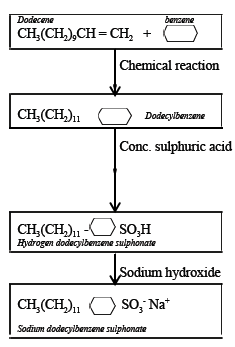
Mode of action of Soapless Detergent
-Soapless detergents have two ends; a long hydrocarbon part, the tail and a short ionic part, the head.
Simple representation of a detergent molecule.
Examples:
- Sodium lauryl sulphate
- Sodium alkylbenzene sulphonate
- The tail is non-polar and dissolves in oil or grease (waterphobic) while the head is polar and dissolves in water (waterphilic).
- Each oil or grease gets sorrounded by the detergent molecules and hence a cloud of charged heads hence repel each other and do not coalesce.
- The dirt (grease loses its direct contact with the fabric being washed.
- Any agitation at this point then removes the dirt from the object.
Advantages of Soapless Detergents Over Soap
- They lather easily with hard water since the corresponding calcium and magnesium salts are soluble in water due to lack of the carboxylate ions.
- Are mainly prepared from non-food raw materials.
- They do not react with acidic water.
Note:
- Soapless detergents with branched chain alkyl groups are not easily broken down by bacteria and are therefore the cause of frothing in sewerage plants, rivers etc.
- Consequently modern industry is overcoming this disadvantage by making the detergents from alkylbenzene with straight chain alkyl groups.
Pollution Effects of Soapless Detergents
- The active ingredients such as alkylbenzene sulphonates are non-biodegradable, hence accumulate in water sources and end up in human bodies.
- Some of the additives such as phosphates cause eutrophication hence excessive build up of algae (algal blooms) which change the water taste and odour, and also reduce oxygen supply hence poor growth of aquatic organisms.
- Because of their high lathering tendency, they cause excessive frothing and foaming in water sources especially after heavy rains.
Comparisons between Soaps and Soapless Detergents
| Detergents | Soaps |
| Have strong cleansing action | Have weaker cleansing acrtion |
| Are highly soluble in water; hence can be used in acidic or hard water | Are not soluble in water and tend to be wasted when used in hard water They cannot be used in acidic water |
| Are made from byproducts of petroleum industry; which helps to conserve edible fats and oils | Are made from edible fats and oils |
| They cause water pollution | Are biodegradable and have minimum pollution effects |
| They are expensive | Are cheaper than detergents |

POLYMERS
- A polymer is a macromolecule formed when two or more molecules link together to form a larger unit.
- Polymers have different properties different from those of the monomers.
- The process of polymer formation is called polymerization.
- Two types of polymers exist; natural and synthetic/artificial polymers.
Natural Polymers and Fabrics
- Natural polymers occur naturally in living systems.
Examples:
- Rubber (latex), starch, cellulose, wool and proteins.
Natural Rubber.
- Rubber trees give out a liquid called latex, which is collected from cuts in the trunks of rubber trees.
- Natural rubber is made out of latex from rubber trees.
- Latex is a hydrocarbon C5H8 , called isoprene (2,methylbut 1,3 diene).
Formula of isoprene
- Coagulation of latex leads to formation of a hydrocarbon polymer consisting of isoprene (2, methylbut-1, 3-diene) units.
- This polymer is called polyisoprene with the formula;
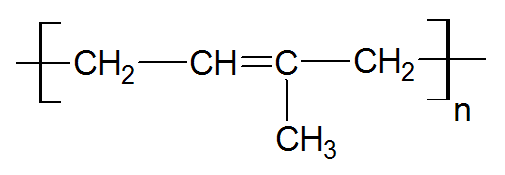
Characteristics of natural rubber. - Soft and sticky;
- Low resistance and low tensile strength; thus breaks easily upon stretching;
- Loses its rubber like properties at temperatures above 60oC;
Note:
- These are not good qualities and for industrial purposes this quality must be improved.
- This is done through vulcanisation of rubber.
Vulcanization of rubber.
- Is a chemical reaction in which raw rubber is heated with sulphur and is done purposely to improve the wear quality of rubber.
Process of vulcanization;
- Rubber is heated with sulphur
- The sulphur atoms form links between chains of rubber molecules.
- This reduces the number of double bonds in the polymer; making the material tougher, less flexible and less softer.
- During the process the sulphur atoms attach themselves to the rubber molecule in such a way that the molecules become locked in place and are prevented from slipping.
Note: - Soft rubber has about 2% sulphur, while toughened rubber about 10 % sulphur.
- Rubber can also be made artificially in industries and this gives a form of synthetic rubber.
- Other than undergoing vulcanisation it has chemicals that give it desired properties.
- It is made from byproducts of petroleum industry.
- Examples of synthetic rubber include neoprene and thiokol.
Note: Neoprene is made by polymerization of chloroprene (2, chlorobut 1,3 diene), C4H5Cl
Equation:
Properties of synthetic rubber.- Are unreactive, hence they don t react with industrial chemicals like oils, grease, petrol etc.
- Are non-inflammable, as they don t catch fire easily.
- Capable of withstanding wide range of temperatures without changing shape.
- Have high mechanical strength.
Uses of synthetic rubber.- Manufacture of insulating materials for electrical connections.
- Making conveyor and seat belts.
- Manufacture of car tyres and tubes.
- Making gaskets, flexible pipes.
Advantages and disadvantages of natural polymers.
Advantages.
- Are biodegradable hence not a likely cause of environmental pollution.
- Are made from renewable resources such as wool and trees; hence not easily exhaustible.
- Most are not easily flammable hence good materials for items like clothing.
Disadvantages
- Are often very expensive compared to synthetic polymers.
- Some do not last for very long.
- Are easily affected by acids, alkalis, air etc.
Synthetic Polymers
- They are man-made e.g. polythene, Perspex
- They are of two main types; thermoplastic and thermosetting polymers.
Thermoplastic
- Softens on heating and becomes rigid on cooling.
Examples: nylon, polythene, polystyrene, etc.
Thermosetting:
- Are those that become hard on heating and cannot be softened by heating.
Advantages of synthetic polymers and fibres over natural polymers
- They can be made into different shapes easily.
- They are cheaper.
- Are often unaffected by ac ids, alkalis, water and air.
- Are usually less denser and yet stronger
Disadvantages of synthetic polymers and fibres over natural polymers
- Plastics are non-biodegradable hence causes a lot if problems in disposal
- Plastics burn more readily than natural material
- Some synthetic polymers give off poisonous gases when they burn. E. g. polyurethane gives off cyanide and carbon monoxide
Methods of polymerization:
Addition polymerization
- Occurs when unsaturated molecules (monomers) join to form a long chain molecule (polymer) without the formation of any other product.
- Usually the monomers must have at least a double or triple bond.
- One of the bonds in the double or triple bonds in the monomer opens up, and the unbonded electrons form bonds with neighbouring molecules.
Conditions for polymerization.
- High pressures.
Examples.
Polymerization of ethene to Polythene
Calculations involving polymers.- A polyisoprene molecule is represented as:

Given that the relative formula mass of polyisoprene is 748 000, calculate the number of isoprene units in the polymer.
- A polyisoprene molecule is represented as:
Summary on common addition polymers.
| Monomer | Polymer | Properties | Uses |
Ethene |
Polythene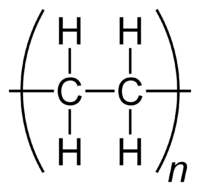 |
Light; tough and durable | Polyethene bags; bowls packaging; electrical insulation; plastic pipes etc |
Propene |
Polypropylene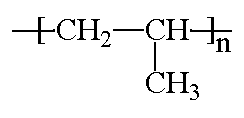 |
Light;tough and durable | making crates, boxes and plastic ropes |
Chloroethene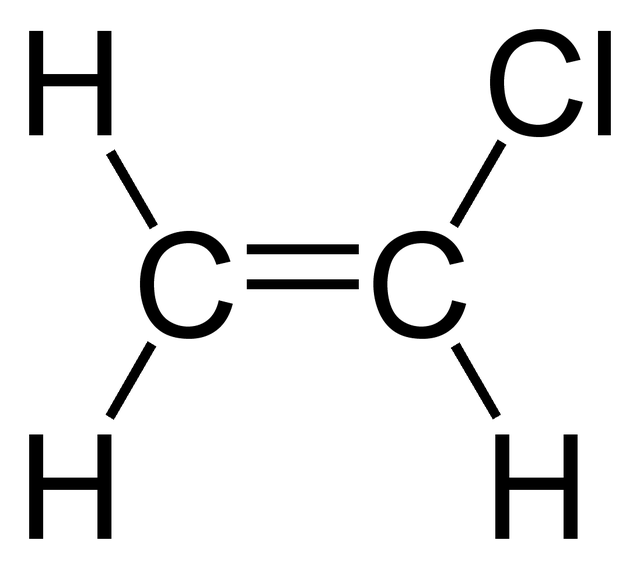 |
polychlroethene (polyvinylchloride)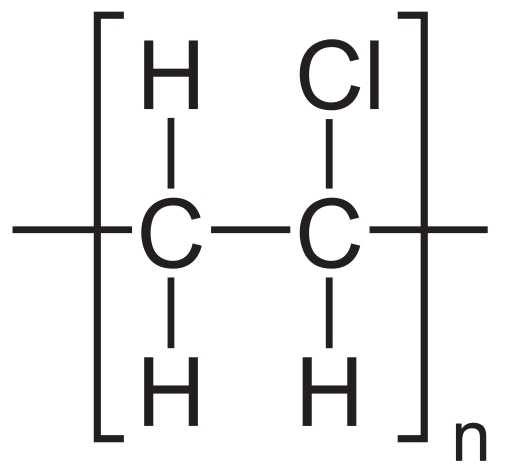 |
Strong and hard (not as flexible as polythene) | Making plastic pipes, electrical insulators, floor tiles, crdit cards |
Phenylethene (styrene)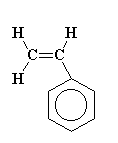 |
Polyphenylethene (polysytrene)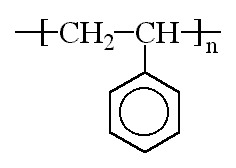 |
Light; poor heat conductor; brittle | Insulation; Packaging materials and food containers |
Tetrafluoroethene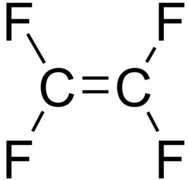 |
Polytetrafluoroethene (Teflon)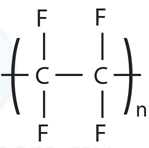 |
Non - stick surface; withstands high temperatures | Non - stick coatings on pans; Insulation |
Methylmethacrylate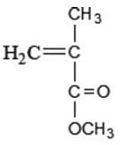 |
Polymethylmethacrylate (Perspex) |
Optical components; transparent doors and windows; display signs; dental fillings |
Condensation polymerization
- Occurs when monomers (similar or different) combine to form a long chain molecule; with the loss of small molecules like ammonia or water.
- The monomers should have at least two functional groups.
Reason: - For molecules to join at both ends permitting chain formation;
Illustration - Consider two molecules A and B; each with 2 functional groups:
- Molecule A; HO - A - OH, with two OH functional groups;
- Molecule B; HOOC - B - COOH, with two -COOH functional groups
On condensation
HO- A- O H + HOOC - B - COOH + HO - A - OH + ...
Hence; Lost to form water
HO - A - OH + HOOC - B - COOH → [HO-A-OOC-B-CO]n + 2H2O(l)
Types of condensation polymers.
- Are of two types:
- Polyesters
- Are polymerized formed by an ester linkage; usually with the liberation of a water molecule.
Example : polyethylene terephthalate (PET) (terylene) - Polyamides
- Are condensation polymer involving monomers that have at least an amine group (in at least one of them); and thus usually result to the evolution of ammonia gas or water.
Example: Nylon 6,6
or
Examples of condensation polymers and their uses.
Polymer Monomer Uses Polyvinyl chloride Vinylchloride Making rain coats, plastic discs, plastic water pipes and electric insulation Starch Glucose Laundry Cellulose Glucose paper and clothing manufacture Silk and wool Proteins (amino acids) Making clothes Polyester (terylene/Dacron) Terephthalic acid and Ethan 1,2 diol (ethylene glycol) Clothes and seat belts Bakelite Urea and methanol Electrical fittings Perspex Methylmethacrylate Safety belts, windscreen and plastic lenses Nylon Hexane - 1,6 - diol dichloride; and hexane - 1,6 - diamine
or Hexanedioic acid and hexane - 1,6 - diamineUsed in making safety glass, reflectors, contact lenses; false teeth
Download ORGANIC CHEMISTRY II - Chemistry Notes Form 4.
Tap Here to Download for 50/-
Get on WhatsApp for 50/-
Why download?
- ✔ To read offline at any time.
- ✔ To Print at your convenience
- ✔ Share Easily with Friends / Students

